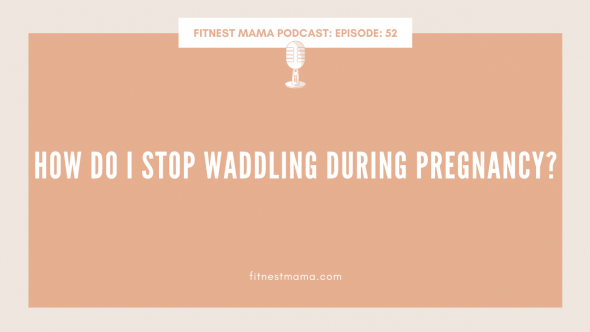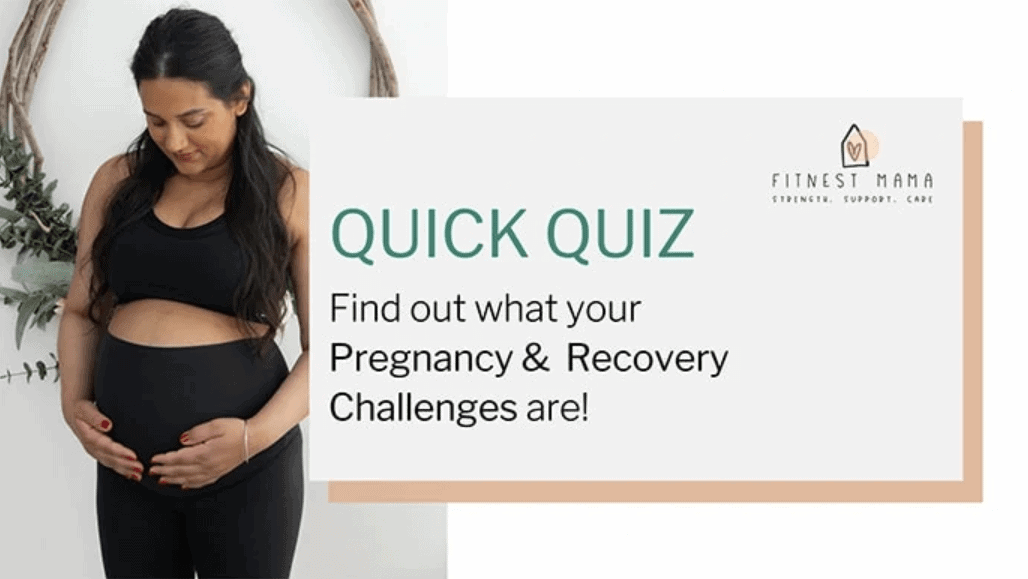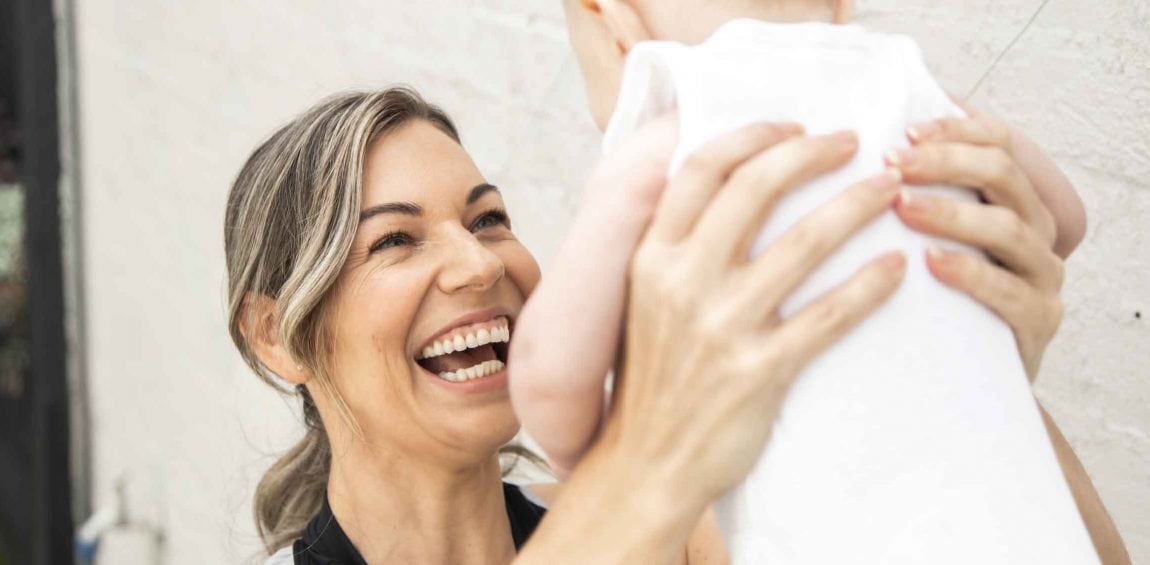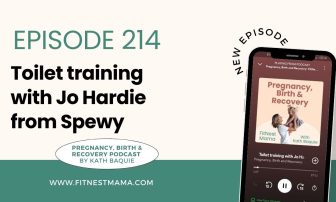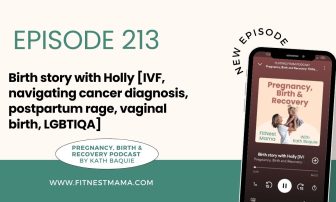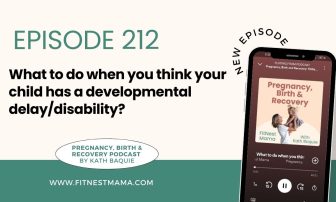Please note that this transcription was completed with computer voice recognition software. Quite often unanticipated grammatical, syntax, homophones, and other interpretive errors are inadvertently transcribed by the computer software. Please disregard these errors. Please excuse any errors that have escaped final proofreading.
If you are pregnant or you’ve recently had a baby, this podcast is for you. I am your host Kath Baquie. A physiotherapist working in women’s health and mum of three. Join me each week as we dive into all things pregnancy care, childbirth, and postnatal recovery, helping you have a wonderful pregnancy and afterbirth experience. And don’t forget to hit subscribe so you don’t miss any episodes.
Welcome to Episode 52 of the FitNest Mama Podcast. I’m your host Kath Baquie. I’m a mum of three young girls, a physio for women. And I have an online community, FitNest Mama, which helps to provide pregnant and new mothers with exercises support and resources they need to feel good from the inside out as they prepare for and recover from childbirth. FitNest Mama has worked out that are tired-mum friendly, achy-mum friendly and toddler-friendly that you can do in the convenience of your home at the end of a long day whilst your Bubba sleeps, or whilst your toddler is running around causing havoc.
So it’s a solo episode today. And we’re chatting, waddling during pregnancy. It’s a question I do get asked about quite a lot inside FitNest Mama and my clients who I see one on one. And it’s something that I think we have all experienced. So firstly, there is nothing wrong with waddling. And I’m sure there comes a time in all our pregnancies, when we might be well prone to a bit more waddling than usual. So this episode is to help you understand why you might be waddling. And whether or not there’s anything that you can do extra to help support your body during this stage of your pregnancy. So I don’t think I need to describe what waddling is, I’m sure we’ve all seen it generally occurs in the third trimester when is a nice big belly. And I know we’ve probably all seen it, or we felt it ourselves. And I know my husband used to delight in taking videos of me waddling. And, and I have to admit, it’s when you see a video of yourself waddling, for myself, it’s a little bit horrifying. And a little bit amusing too because it’s just you look so different to how you normally look during pregnancy. But it’s our body’s way of compensating for what’s happening at this stage of pregnancy.
So let’s talk about the changes that are occurring in the bodies just so that we understand a little bit more about it. So during your pregnancy, there’s a different hormone that are racing around your body to help your body get ready for childbirth. In addition, we’ve got the added weight of the baby, so your baby is growing, and your abdominal muscles are becoming stretched. The added weight might be pulling your centre of gravity forward slightly; your boobs might be growing. So there’s all these different, I guess weight distributions in the body that can be contributing to the shift of gravity. The point centre of gravity isn’t the same as when you are not pregnant. And especially as your pregnancy progresses and your belly gets bigger, your centre of gravity is changing. So then we also have the fact that we might have extra aches and pains or stiffness as well during pregnancy. And that’s why I like to think about waddling as a factor of controllable factors and non-controllable factors. We can’t do anything about the different hormones in our body.
We can’t do anything about the size of our baby and the growth that’s happening within our body, our boobs and our belly, all those beautiful changes. We can’t do anything about those shifts in gravity. So let’s chat about some things that might be in your control. Again, what I’m saying here isn’t designed to stop you from waddling and as I said before, that I’m sure there comes a stage in all our pregnancies where we might be more prone to waddling. I guess this is just to get you thinking, is there anything I could be doing to help support my body a little bit more during this stage of pregnancy? Right. So the first thing, which I think is really important is not to put up with aches and pains. I know a lot of women just say, Oh, I’m pregnant. So yeah, I’m just I’m going to be stiff and achy. Or you know, I’m pregnant. So I’m just going to put up with this until I have my baby. The first tip would be, let’s get management plan for any aches and pains. You know, you want to enjoy your pregnancy as much as possible, you want to get the most out of your pregnancy and to be worried by excellent pains, it’s not nice. And I know this, my second pregnancy was riddled with aches and pains. So let’s just get a management plan. And that might include whether or not you’re going to see someone for one on one treatment that might include massage, or it might just include self management strategies might be enough. So I’ll go through a few of those tips in a little bit. So stay tuned. So a management plan for aches and pains, but also a plan for your body’s flexibility, posture, and strength. I am a big believer that we are giving so much for our growing baby, we are growing a beautiful baby, we’re giving our body over to this growing baby and to be able to invest in ourselves and help support ourselves I think is so important for pregnancy, but also for after birth recovery. And we all deserve to invest in ourselves you want your body to we all want our bodies to serve ourselves as much as possible and as best possible for the rest of our lives. So let’s get a management plan for your flexibility, posture and strength. So here are a few tips for bullet-proofing against a waddling.
Tip number one is let’s be aware of our posture. So when as our belly gets bigger, you’re more likely to want to naturally fall into a bit of a sway back posture. So that’s more of a lumbar lordosis. So this is where you might notice your bottom sticking out a bit more than usual, you’ve got more of an arch in your back, your belly might be flopping forwards. This problem with these postures, it might well lead to a back aches and pains. So it might affect your centre of gravity even more and make you waddle more, but it might also predispose you to back pain. So what can we do, we can’t do anything about our growing belly. But let’s stay flexible in that lumbar spine as much as possible. I love pelvic tilts, pelvic tilts and standing just doing a few on the hour every hour. So if you don’t know what pelvic tilts are head to my Instagram, @fitnestmama, because pretty much every workout that I show involves pelvic tilts, you can do them in four-point kneeling in sitting in standing. And big right, you can do them before you stand up. If you know you’re a bit achy, when you first stand up from sitting, you can do just two or three pelvic tilts just to get that some movement in your lower spine.
The second tip would be changing up his sitting posture. So let’s say it’s your first pregnancy, you might be working full time. Let’s change up your sitting posture so that you’re not in one posture all day. So you might first of all have a look at your desk station. And let’s try to get your hips at 90 degrees and your elbows roughly at 90 degrees when you’re at the desk. But secondly, you might choose to substitute a desk chair with a football for an hour a day, you might try standing for a little period of time. And then the other little tip is to actually try sitting backwards on a chair. I might have said that wrong. So turn a chair around so that you can sit so that your front is on the back of the chair. And sometimes I find this helps you to relax into a bit more of a posterior pelvic tilt. So it helps to prevent that arch helps to reduce that arch that can naturally happen especially as your belly is getting bigger.
And then the other tip for you sitting posture is sitting on a gently rolled up towel can also help. So popping in towel length way on the back of the chair just so that your sit bones is sitting up a bit up a bit higher. And that can sometimes take a bit of extra pressure on that lumbar extension that has to happen. So just try these out, you might find one of those tips works really well for you. You know, take what works for you and leave what doesn’t. Okay, and for mums with toddlers that aren’t finding they’re sitting all day by getting creative in what you can do to help reduce how much you have to lift your toddler because whilst your body is changing, and let’s say you are finding your waddling, or your bellies belly is getting bigger, everything’s a bit out of whack and you are more prone to injury, your abdominal muscles are put on stretch. So there’s less strength and actually around the core. So trying to avoid lifting those heavy toddlers can be really helpful in helping to reduce aches and pains. So let’s get creative about how much you have to reduce the amount of toddler lifting and I know this won’t always be avoidable. Sometimes you just have to lift. But even if we reduce the lifting from 100% to 70%, so for moms with toddlers, let’s get creative in how to reduce the amount of toddler lifting, so steps in the kitchen steps in the bathroom steps in the bedroom, so you might get some lightweight portable steps that you can move around the house.
We talked about targeting any issues with aches and pains. So self-management strategies such as using a spiky ball for a bit of massage into your glutes, learning what stretches you can do so some glutes strictures, those pelvic tilts, I love open book stretch. Again, just come and check out my Instagram page, I have heaps of stretches on there. And this is something we cover a lot inside FitNest Mama too. I’ve talked about how much I love pelvic tilts. And I will also link in the show notes for this episode. I’ve done a previous podcast episode that’s all about pelvic girdle pain, and ways to help manage pelvic girdle pain. So I’ve done a previous podcast episode. So I’ll link that in the show notes. So check that out. I won’t repeat it all again.
And then finally, as I said before, do go and see a physio if symptoms persist, and if they don’t improve, and you’re just needing a bit of extra help. So sometimes self-management strategies can help to nip it in the bud and help to prevent any further issues with aches and pains. But sometimes you do need a bit of extra support too. And then the last thing, I guess the bullet-proofing against waddling is to stay as flexible as possible and stay as fit and active and strong as possible. And this is where FitNest Mama can really help. FitNest Mama has workouts perfect for the third trimester. Not all stages of pregnancy, but we’ve got third trimester specific workouts that really help with stiffness. It helps read your posture. It helps with the strength and flexibility. And then there’s also workouts to help with childbirth preparation. So how can we prepare your pelvic floor for childbirth? And how can we learn about our pelvic floor to help with postnatal recovery? I guess it’s easy to say stay fit and active and strong, but how are you going to do it. And I think this is where it can be really challenging for mums. We all know what we should be doing. But to actually do some things is really hard. I get it if you’re busy, you’re working you’ve got lots of appointments you might have toddlers and other children to look after. To be able to dedicate even just 10 minutes of the day to yourself, where you can do some stretches and exercises to help support your growing belly can really help.
Women are often happy to spend heaps on nurseries and prams baby clothes, yet often hesitate to spend the money on investing in themselves. But for just over $5 a week, which is what the FitNest Mama Membership is for six months to six months of workouts and support to help you flourish during pregnancy and postpartum to help bulletproof you against waddling and to help you feel good on the inside and out. So hopefully that was helpful. If you are waddling. Don’t worry. Like there’s so many things that this is just part of normal pregnancy. But hopefully this has also helped you to think Is there anything extra can be doing just to help me feel really good on the inside and out. So just a short episode today ladies, but hopefully that was helpful in identifying why you might be waddling and whether or not there’s anything you can be doing to help support your body during this beautiful time.
And don’t forget if you do want to come and join us inside FitNest Mama, for some pregnancy or workouts, some trimester specific workouts and preparation for birth so that you can really just invest in your body and help you feel good on the inside and out. Then come and join us at ww.fitnestmama.com. So my team and I will be putting together the Show Notes for this episode with all the links including how to access that previous podcast episode all about pelvic girdle pain at www.fitnestmama.com/podcast. Have a brilliant day everyone and I look forward to you joining me next week for another episode of the FitNest Mama Podcast.
Thanks for listening to the FitNest Mama Podcast brought to you by the FitNest Mama Freebies found at www.fitnestmama.com/free. So please take a few seconds to leave a review, subscribe, so you don’t miss an episode. And be sure to take a screenshot of this podcast, upload it to your social media and tag me, @fitnestmama, so I can give you a shout out too. Until next time! Remember, an active pregnancy, confident childbirth, and strong postnatal recovery is something that you deserve. Remember, our disclaimer, materials and contents in this podcast are intended as general information only and shouldn’t substitute any medical advice, diagnosis or treatment. I’ll see you soon!
